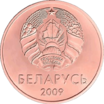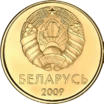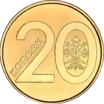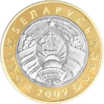Belarusian ruble
| ruble | |
|---|---|
| Country: |
|
| Subdivision: | 100 kopecks |
| ISO 4217 code : | BYN |
| Abbreviation: | Br |
|
Exchange rate : (29 Mar 2020) |
1 EUR = 2.806 BYN 1 CHF = 2.6076 BYN |
The Belarusian ruble ( Belarusian Беларускі рубель Belaruski rubel ; ISO-4217 code BYN , abbreviation also Br ) is the currency of Belarus .
The first Belarusian ruble (BYB) was introduced in May 1992. One Belarusian ruble replaced 10 Soviet rubles . The second Belarusian ruble was introduced in 2000, three zeros were deleted: 1 BYR = 1000 BYB . On July 1, 2016, the third Belarusian ruble (BYN) was introduced in the ratio of 1 new ruble (BYN) = 10,000 old rubles (BYR) . Since then, coins have also been in circulation for the first time.
Denomination
There are banknotes with values of 5, 10, 20, 50, 100, 200 and 500 Br, as well as coins with values of 1, 2, 5, 10, 20 and 50 kopecks, and 1 and 2 rubles. Banknotes of the old series from 100 Br remained valid in a transitional period.
From the previous ruble there were banknotes with the values 1, 5, 10, 20, 50, 100, 500, 1000, 5000, 10,000, 20,000, 50,000, 100,000 and 200,000 Br; Circulation coins did not exist before the changeover in July 2016. The first ruble from 1992 to 2000 was divided into 100 kopecks. When the currency changed over in 2000, no new kopeck coins or banknotes were produced.
First series (1992-2000)
Second series (2000-2016)
Third series (since 2016)
| Coins (since 2016) | |||||||||
|---|---|---|---|---|---|---|---|---|---|
| image | value | ||||||||

|

|
1 kopeck | |||||||

|

|
2 kopecks | |||||||

|

|
5 kopecks | |||||||

|

|
10 kopecks | |||||||

|

|
20 kopecks | |||||||

|

|
50 kopecks | |||||||

|

|
1 ruble | |||||||

|

|
2 rubles | |||||||
| Banknotes (since 2016) | |||||||||
|---|---|---|---|---|---|---|---|---|---|
| image | value | ||||||||

|

|
5 rubles | |||||||

|

|
10 rubles | |||||||

|

|
20 rubles | |||||||

|

|
50 rubles | |||||||

|

|
100 rubles | |||||||
|
|
|
200 rubles | |||||||
|
|
|
500 rubles | |||||||
history
The current ruble ( BYN ) was introduced in July 2016 as a new ruble in the ratio of 1 new = 10,000 old ruble (BYR) . This was introduced in 2000 as a new ruble in the ratio of 1 new = 1000 old rubles (BYB) .
The name of the Belarusian currency comes from the Soviet ruble , which was kept after the collapse of the Soviet monetary system in 1991. Plans to introduce a national currency unit to be called the thaler were not put into practice.
In early 1992, during the breakup of the Soviet monetary system, a system of temporary payment receipts was introduced.
On June 1, 1992, the Belarusian currency was introduced for bookings. From the end of June 1993, Russian and Soviet rubles were no longer accepted as a means of payment. Belarus pressed ahead with preparations for the introduction of its own currency, although in September 1993 it signed an agreement with Kazakhstan , Armenia , Russia , Uzbekistan and Tajikistan in which the goal of a common post-Soviet currency zone was explicitly formulated.
Currency policy of the Lukashenka government
A connection to the Russian monetary system was also considered. In 1996, the government of Alyaksandr Lukashenka took control of the previously independent Belarusian national bank. This lost the possibility of an independent currency policy .
Two national bank chairmen ( Stanislau Bahdankewitsch and Tamara Winnikawa ) resigned in protest against the subordination of the national bank to the cabinet of ministers. As a result Pyatro Prakapowitsch became chairman of the National Bank.
During this period, recession and an increasing black market dominated the country's economy. The government sought to restrict free price formation on the national currency market and introduced restrictions on currency trading that affected both companies and private individuals.
In 1999 the official exchange rate was around a third of the rate on the black market. This contradiction is seen as the reason why official reports of the time spoke of a "gigantic growth" of the Belarusian economy, while calculations based on the black market rate showed negative developments.
The economic policy of the Lukashenka government required a high financial outlay. The government let the National Bank print more and more money, so that typical inflationary effects occurred. The ruble corresponded to an ever decreasing value of goods, the prices rose.
The national debt to banks multiplied by a factor of 15 between 1996 and 2000, while the banks, in accordance with government guidelines, mainly granted loans to unprofitable agriculture. Of the 27 private banks, around a third had gone bankrupt by January 2000 . The money in circulation was roughly 500 times the annual national income .
In September 1999, the central bank issued the highest quality banknote at 5 million rubles. Like most currencies in isolated and weak economies, the Belarusian ruble was rarely used for international financial transactions.
Monetary union with Russia
Since the beginning of his presidency, Lukashenka has worked towards the country's integration with the Russian Federation , which is supported by left-wing conservatives in Belarus and nationalists in Russia, among others. To this end, Russian President Boris Yeltsin and Aljaksandar Lukashenka signed several agreements between 1995 and 1999 on a Russian-Belarusian union . The introduction of a common currency was also planned from the start. Article 13 of the " Treaty on the Establishment of the United States of Russia and Belarus " signed in 1999 spoke of a currency unit for the Union.
The location and control of the new common central bank were initially not bindingly clarified. Moscow and Minsk were traded as possible locations. Yeltsin's successor, Vladimir Putin, slowed down the unification process and urged Russia to have more influence in the Union.
In 2000, the National Bank adjusted the official rate of the currency to the shadow rate and liberalized currency trading. Since then, the Russian side has called for exchange rate stability as the central bank's top priority.
In December 2002, at the meeting of the Prime Ministers of Belarus and Russia, it was declared that the Russian ruble would initially be the common currency. It was planned that the Russian ruble would be introduced in Belarus for cashless transactions from July 1, 2003 and would completely replace the Belarusian currency from January 1, 2004. In 2007 or 2008 a new transnational currency should be introduced. Since then, binding steps have been postponed several times. It is disputed among observers whether both countries still have a serious interest in a common currency and in further integration in the Union . On the Russian side, it was recently suspected that the government in Minsk was only using the planned union as an excuse to force Russia to support the Belarusian economy.
Foreign exchange crisis since 2011
Belarus has been in a foreign exchange crisis since the end of 2010, which experts believe is at least indirectly due to the outcome of the presidential elections on December 19, 2010 . Persistent rumors that the country is on the verge of national bankruptcy have led the population to stock up on foreign currency for fear of a drastic devaluation of the Belarusian ruble. Although the Belarusian government is trying to counteract this development through purchase restrictions, it must, however, continue to cover the currency requirement with foreign loans. Since Minsk, on the other hand, is trying to stick to the previous system of a state-controlled economy, even eastern partner countries show little interest in providing Belarus with the necessary financial aid.
In March 2011 credit negotiations with the partners of the Eurasian Economic Community (EAWG) failed . The lack of urgently needed foreign currency aggravated the latent economic crisis in the country and led to a further run on foreign currencies. While the state tried, for psychological reasons, to keep the exchange rates stable for private individuals, the rates in interbank trading were up to 100% above the officially published rates as early as the beginning of May 2011. For example, business people had to pay up to 6500 rubles for one US dollar , although the official rate at the counters was still given as 1: 3100.
On May 24, 2011, the central bank reacted to the fall in the value of the ruble with a drastic cut. Over a weekend, it depreciated the ruble by around 35% - while the dollar and euro exchange rates were 1: 3155 and 1: 4516 respectively on Friday, May 20, the official dollar exchange rate on Tuesday, May 24, was 4930 BYR and the euro rate with 6914 BYR.
In order to counter the persistent shortage of foreign currency, the Belarusian Central Bank approved payment transactions in foreign currencies on May 26, 2011. According to this, foreign citizens in Belarus are now allowed to pay directly in their home currencies at gas stations, hotels or medical facilities. It is planned to extend the new regulation to other areas of the economy.
After the European Bank for Reconstruction and Development (EBRD) refused any financial commitment in the Belarusian state sector, an agreement was reached with the Eurasian Economic Community (EAWG) in May 2011 . It granted Belarus a $ 3 billion rescue loan, which was to be disbursed in installments , provided the Belarusian government had privatized state property in accordance with the contract (totaling $ 7.5 billion).
As a result of the ongoing currency crisis, the President of the Central Bank, Pyatro Prakapowitsch, was replaced by his previous deputy Jury Alymow on June 20, 2011 . President Lukashenka commented on this decision by saying that Prakapovich made mistakes, the government made mistakes and he (Lukashenka) must respond.
From October 20 to 21, 2011, the Belarusian National Bank devalued the ruble again this time by 34%, from one US dollar for 5712 rubles to one dollar for 8680 rubles.
Due to inflation, the Belarusian bank issued the 200,000 ruble note in 2012. At that time, 200,000 rubles was equivalent to around 19 euros. At the end of 2015, the rate was around 1: 20,300, so that only just under 10 euros were exchanged for said 200,000 ruble note.
Currency reform 2016
In Belarus, on July 1, 2016, the face value of the national currency was reduced by four decimal places. In accordance with the relevant decree by President Alexander Lukashenko, the new banknotes and coins that have been in the National Bank's stores since 2008 will come into circulation from this point in time. That is why the year 2009 is on the new cash and the signature of the then President of the Central Bank is on the banknotes. Due to the economic crisis in 2009, the currency reform had been postponed indefinitely. In a transitional period between July 1 and December 31, 2016, the old and new prices will appear on all price tags in the country and old and new banknotes will circulate in parallel. From January 1, 2017, old banknotes can still be exchanged in banks, from 2020 to the end of 2021 only in the central bank.
Exchange rate
- January 1, 2010 - 1 EUR = 4,119.53 BYR
- January 1, 2011 - 1 EUR = 3,999.30 BYR
- January 1, 2012 - EUR 1 = BYR 10,800.00
- January 1, 2013 - 1 EUR = 11,340.00 BYR
- January 1, 2014 - 1 EUR = 13,130.00 BYR
- January 1, 2015 - EUR 1 = BYR 14,460.00
- January 1, 2016 - EUR 1 = BYR 20,300.00
- January 1, 2017 - 1 EUR = 2.0450 BYN
- January 1, 2018 - 1 EUR = 2.3553 BYN
- January 1, 2019 - 1 EUR = 2.4734 BYN
- January 1, 2020 - 1 EUR = 2.3637 BYN
Source: National Bank of the Republic of Belarus
Web links
- National Bank of the Republic of Belarus (Russian, Belarusian, English)
- National Bank exchange rates (English)
- Belarusian commemorative coins (German, English)
- Historic banknotes from Belarus ( German ) ( English )
Individual evidence
- ^ Voice of Russia : Political dispute: Russia's finance minister accuses Belarus of blackmail attempts (accessed on July 26, 2011).
- ↑ RIA Novosti : Currency crisis in Belarus is the result of the most recent presidential election , accessed on May 24, 2011.
- ↑ RIA Novosti : Inflation in Belarus higher than expected (accessed November 1, 2011).
- ^ RIA Novosti : Foreign exchange crisis in Belarus: Restrictions now also for credit cards (accessed on May 12, 2011).
- ^ Voice of Russia : Currency crisis: Moscow refuses Belarus a rescue loan (accessed on May 12, 2011).
- ^ RIA Novosti : First reforms, then credit - calls for Eurasian Economic Community of Minsk (accessed on May 12, 2011).
- ^ Wall Street Journal of May 16, 2011: Belarus's Isolation Hammers Ruble , accessed on May 17, 2011 ( see also Charter 97 of May 17, 2011 ).
- ↑ RIA Novosti : Central Bank of Belarus devalues national currency by 50 percent , accessed on May 23, 2011. Note: the figures given are a depreciation of the ruble by 36% against the US dollar and 34.7% against the euro.
- ↑ RIA Novosti : Belarus' central bank approves payment transactions in foreign currencies , accessed on May 26, 2011.
- ↑ Voice of Russia : EBRD refuses financial aid to Minsk , message dated May 25, 2011.
- ↑ Voice of Russia : Because of the rescue loan : Belarus has to privatize assets for 7.5 billion dollars , message dated May 24, 2011.
- ↑ Bloomberg.com : Lukashenko Replaces Belarus Central Bank Chief With His Deputy , notification dated June 23, 2011, accessed June 24, 2011.
- ↑ Exchange rates of the Belarusian National Bank
- ↑ Belarus before bankruptcy in: Der Standard from October 20, 2011, accessed on October 20, 2011.
- ↑ Belarus introduces new currency on chek24.de
- ^ National Bank of the Republic of Belarus















































